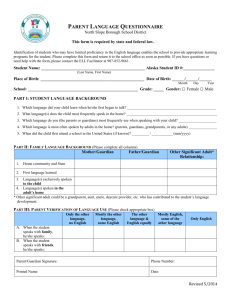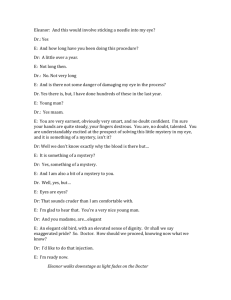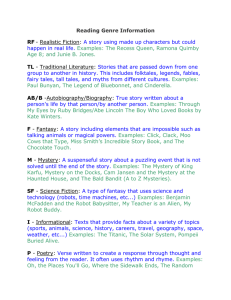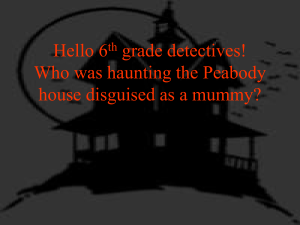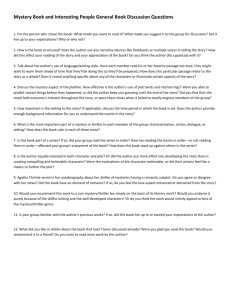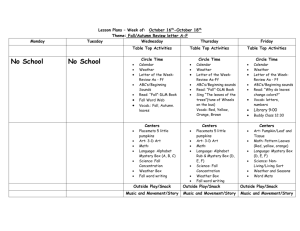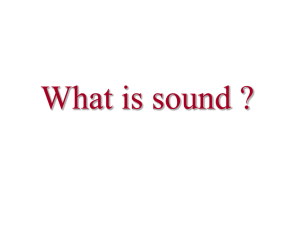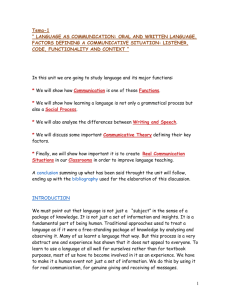Speaking in the Classroom Handout
advertisement
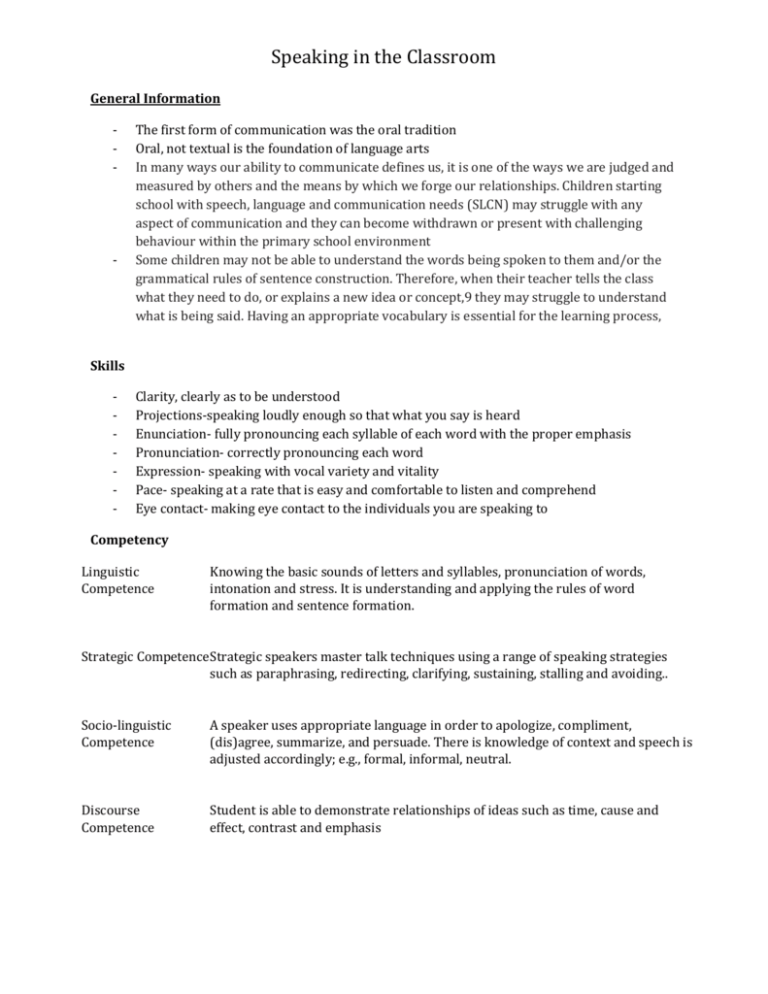
Speaking in the Classroom General Information - - The first form of communication was the oral tradition Oral, not textual is the foundation of language arts In many ways our ability to communicate defines us, it is one of the ways we are judged and measured by others and the means by which we forge our relationships. Children starting school with speech, language and communication needs (SLCN) may struggle with any aspect of communication and they can become withdrawn or present with challenging behaviour within the primary school environment Some children may not be able to understand the words being spoken to them and/or the grammatical rules of sentence construction. Therefore, when their teacher tells the class what they need to do, or explains a new idea or concept,9 they may struggle to understand what is being said. Having an appropriate vocabulary is essential for the learning process, Skills - Clarity, clearly as to be understood Projections-speaking loudly enough so that what you say is heard Enunciation- fully pronouncing each syllable of each word with the proper emphasis Pronunciation- correctly pronouncing each word Expression- speaking with vocal variety and vitality Pace- speaking at a rate that is easy and comfortable to listen and comprehend Eye contact- making eye contact to the individuals you are speaking to Competency Linguistic Competence Knowing the basic sounds of letters and syllables, pronunciation of words, intonation and stress. It is understanding and applying the rules of word formation and sentence formation. Strategic CompetenceStrategic speakers master talk techniques using a range of speaking strategies such as paraphrasing, redirecting, clarifying, sustaining, stalling and avoiding.. Socio-linguistic Competence A speaker uses appropriate language in order to apologize, compliment, (dis)agree, summarize, and persuade. There is knowledge of context and speech is adjusted accordingly; e.g., formal, informal, neutral. Discourse Competence Student is able to demonstrate relationships of ideas such as time, cause and effect, contrast and emphasis Speaking in the Classroom Research - Some types of sound errors put children more at risk for reading and spelling problems than others- Tyquin Group, speech pathology and reading clinic The development of speaking and listening skills requires fuller and more intensive attention to make sure that children acquire a good stock of words, learn to listen attentively, and speak clearly and confidently. …they are prime communication skills, hugely important in their own right and central to children’s intellectual, social and emotional development.” - Vygotsky A Teacher's Role: Initiating and Exploring Speech in the Classroom To Prompt Speaking in the Classroom - Instead of having a teacher directed question and answer lecture create a discussion. Ask questions such as "What do you mean? or Why do you think so?". Involve each student in every speaking activity. Know your students interests so that they are eager to participate. Promote the different types of speech in the classroom. This includes different dialects and linguistics. If you have students that are ELL allow them to speak in their own ways of talking. Speaking does not always have to be formal. Practicing Speaking in the Classroom - Activities involving speech should not be isolated lessons but rather integrated into lessons on a frequent basis Allow maximum practice of speech in lessons. This includes sharing, discussion, jigsaws, etc. Supporting speech in the Classroom - Teachers should offer support to students when practicing speech. Positive reinforcement and suggestions are crucial in order to build on success. Sharing Speech in the Classroom - - Encourage an active classroom that involves a variety of activities that encourage speech. This could include small-group discussions, drama games, conversations amongst each other, etc. Promote sharing of ideas amongst different school audiences such as younger grades, different adults, or special guests. Reducing Teacher Direction in the Classroom - Classroom learning should be aimed to include purposeful and engaging talk Teachers should Teachers should encourage and cultivate discussion as exploration rather than typical recitation and repetition. Speaking in the Classroom - When teachers reduce their speaking time in the classroom, student speaking time will increase. This will result in a higher confidence in the students. Theory Implications Learning standards for school discourse rituals : For example raising hands, taking turns, not shouting out, and answering a question on demand.) Learning to be on topic. (ie. introducing, maintaining and appropriately ending a topic.) Learning to distinguish when knowledge is shared by a conversational partner and when it is not. Thoughts on Assessment Focused observations: individual or small group Assess products created during process of learning not only final products that are a result of learning. Select oral samples for a portfolio Activities to Assess Oral Language Language of Social Interaction - Activity based sharing: informal, structured, formal - Discussion: partner, small group, informal debate, whole class - Social Conventions: communication, problem solving, contexts for speaking and listening courtesies Language and Literacy - Newstelling Formal presentations Assembly performances Narrative: modelled stories, character interviews, role play, story reconstruction, circle stories Description: barrier games, description activities Language and Thinking - Partner work: collaborative learner / adoption of roles Inquiry: questioning, interviewing, creative inquiry Classification: comparing and grouping, brainstorming and building knowledge Speech Development - Observe and record on checklists Speaking in the Classroom - Track developmental progress Monitor children at risk Call on speech therapists, special needs teachers for opinions/support Areas to Focus Speech Assessment Behaviours Vocabulary Language Structures Speech Sounds - Uses appropriate volume and tone of voice - Knows how to take turns when speaking - Stays on topic - Asks questions - Seems to pay attention when another person is speaking - Can name colors, numbers, and familiar objects - Uses vocabulary appropriately for purpose and audience - Is able to retell parts or all of a story read aloud - Understands and uses prepositions such as over, under, in, out, beside, etc - Understands directions - Can use connectors such as: and, so, because, if - Often speaks in complete sentences - Generally speaks with grammatical correctness - Articulates speech sounds correctly - Speaks clearly and fluently Activities: *It is important to note that almost all activities in the classroom can incorporate some sort of speaking element, the important part is to establish a classroom community before hand. “Pass the Beat” – An initial icebreaker for students to engage in, in order to feel comfortable sharing in a group setting. In small or large group, ask students to stand in a circle. Choose one person to share the clap. They pass the beat to the person next to them, ensuring eye contact. Students can work towards increasing the speed over time. “Mystery Box Activity” – As seen in class. Can be modified for a variety of levels and topics. Mystery box activity Step 1 – Have one member in the group read the instructions out loud to your group. Step 2 – “get to know” your mystery item Step 3 – You will have 7 minutes to prepare a quick 30 second speech about your mystery item in the following form _________________________________________________________ ** Keep this form a secret within your group. Once the speech is presented, your classmates are going to guess which form you presented. Step 4 – It is up to you to decide if you want to delegate one representative from the group to present, or if you would like to include all group members. Step 5 – HAVE FUN! Step 6 – Be ready to present when the timer runs out Speaking in the Classroom “Spoken Word Poetry” “Show and Tell” – Can be used in a variety of age groups and subject matters. Show and Tell can be a great form of formative assessment “I didn’t say she stole my lunch” – ask students to place the emphasis on different words. Have a quick discussion as to how the sentence changed over the course of the 7 different times it was spoken to illustrate the importance of speaking and communication. “Funny Holiday Activity” - http://www.onestopenglish.com/skills/speaking/lesson-plans/pdfcontent/speaking-skills-lesson-plans-first-day-worksheet/teachers-notes-all-levels/149727.article Resources "Talking Classrooms- Shaping Children's Learning Through Oral Language Instruction" - Patricia G.Smith Public Speaking Rubric http://www.sites4teachers.com/links/redirect.php?url=http://www.tusculum.edu/research/ documents/PublicSpeakingCompetencyRubric.pdf Sample Speech Rubric http://www.sites4teachers.com/links/redirect.php?url=http://content.scholastic.com/conte nt/collateral_resources/pdf/l/lessonplans_pdf_june05_RubricForSpeeches.pdf Gordon Pershey, Monica (2001) "A Rationale for Classroom Listening and Speaking Instruction," Language Arts Journal of Michigan: Vol. 17: Iss. 2, Article 5. Available at: http://dx.doi.org/10.9707/2168-149X.1317
